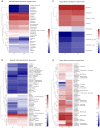Effects of Bacillus subtilis T6-1 on the Rhizosphere Microbial Community Structure of Continuous Cropping Poplar
- PMID: 35625519
- PMCID: PMC9138279
- DOI: 10.3390/biology11050791
Effects of Bacillus subtilis T6-1 on the Rhizosphere Microbial Community Structure of Continuous Cropping Poplar
Abstract
The continuous cropping obstacles in poplar cultivation cause declines in wood yield and serious soil-borne diseases, mainly because of structural alterations in the microbial community and the aggregation of pathogenic fungi. Bacillus subtilis T6-1, isolated from poplar rhizospheric soil, has strong antagonistic effects on poplar pathogens. We aimed to investigate the effects of B. subtilis T6-1 on the structure of the microbial community in the poplar rhizosphere. Poplar seedlings were replanted in three successive generations of soil. The diameter at breast height, plant height, and the number of culturable bacteria of the poplars inoculated with T6-1 exceeded those in the non-inoculated control group. qPCR analysis revealed that the total abundance of T6-1 bacteria in the treated poplars was remarkably higher in contrast to that in the control group. Illumina MiSeq sequencing was employed to track the alterations in diversity and structure of the total microbial community in the poplar rhizosphere inoculated with B. subtilis T6-1. Fungal diversity and abundance in the T6-1 rhizosphere were remarkably lower in contrast with those in the control rhizosphere. The proportion of Bacillus sp. in the total bacterial community in the T6-1 and control groups was 3.04% and 2.38%, respectively, while those of the Rhizoctonia sp. was 2.02% and 5.82%, respectively. In conclusion, B. subtilis T6-1 has the potential to serve as a microbial agent, enhancing the structure of the rhizosphere microbial community as well as promoting tree growth in poplar cultivation.
Keywords: Bacillus subtilis; continuous cropping obstacles; microbiology community structure; poplar; rhizosphere.
Conflict of interest statement
The authors declare no conflict of interest.
Figures





Similar articles
-
Effects of a Microbial Restoration Substrate on Plant Growth and Rhizosphere Microbial Community in a Continuous Cropping Poplar.Microorganisms. 2023 Feb 15;11(2):486. doi: 10.3390/microorganisms11020486. Microorganisms. 2023. PMID: 36838451 Free PMC article.
-
A plant growth-promoting bacterium alters the microbial community of continuous cropping poplar trees' rhizosphere.J Appl Microbiol. 2019 Apr;126(4):1209-1220. doi: 10.1111/jam.14194. Epub 2019 Feb 18. J Appl Microbiol. 2019. PMID: 30614155
-
Microecological Shifts in the Rhizosphere of Perennial Large Trees and Seedlings in Continuous Cropping of Poplar.Microorganisms. 2023 Dec 28;12(1):58. doi: 10.3390/microorganisms12010058. Microorganisms. 2023. PMID: 38257884 Free PMC article.
-
Biological Control of Melon Continuous Cropping Obstacles: Weakening the Negative Effects of the Vicious Cycle in Continuous Cropping Soil.Microbiol Spectr. 2022 Dec 21;10(6):e0177622. doi: 10.1128/spectrum.01776-22. Epub 2022 Oct 27. Microbiol Spectr. 2022. PMID: 36301101 Free PMC article.
-
Autotoxins in continuous tobacco cropping soils and their management.Front Plant Sci. 2023 Apr 17;14:1106033. doi: 10.3389/fpls.2023.1106033. eCollection 2023. Front Plant Sci. 2023. PMID: 37139103 Free PMC article. Review.
Cited by
-
Editing Metabolism, Sex, and Microbiome: How Can We Help Poplar Resist Pathogens?Int J Mol Sci. 2024 Jan 21;25(2):1308. doi: 10.3390/ijms25021308. Int J Mol Sci. 2024. PMID: 38279306 Free PMC article. Review.
-
Impact of Plant-Beneficial Bacterial Inocula on the Resident Bacteriome: Current Knowledge and Future Perspectives.Microorganisms. 2022 Dec 13;10(12):2462. doi: 10.3390/microorganisms10122462. Microorganisms. 2022. PMID: 36557714 Free PMC article. Review.
References
-
- Xi B., Clothier B., Coleman M., Duan J., Hu W., Li D., Di N., Liu Y., Fu J., Li J., et al. Irrigation management in poplar (Populus spp.) plantations: A review. For. Ecol. Manag. 2021;494:119330. doi: 10.1016/j.foreco.2021.119330. - DOI
-
- Wang Y., Bai G., Shao G., Cao Y. An analysis of potential investment returns and their determinants of poplar plantations in state-owned forest enterprises of China. New For. 2014;45:251–264. doi: 10.1007/s11056-014-9406-z. - DOI
-
- Cheng S., Xu Z., Su Y., Zhen L. Spatial and temporal flows of China’s forest resources: Development of a framework for evaluating resource efficiency. Ecol. Econ. 2010;69:1405–1415. doi: 10.1016/j.ecolecon.2009.04.006. - DOI
Grants and funding
LinkOut - more resources
Full Text Sources

